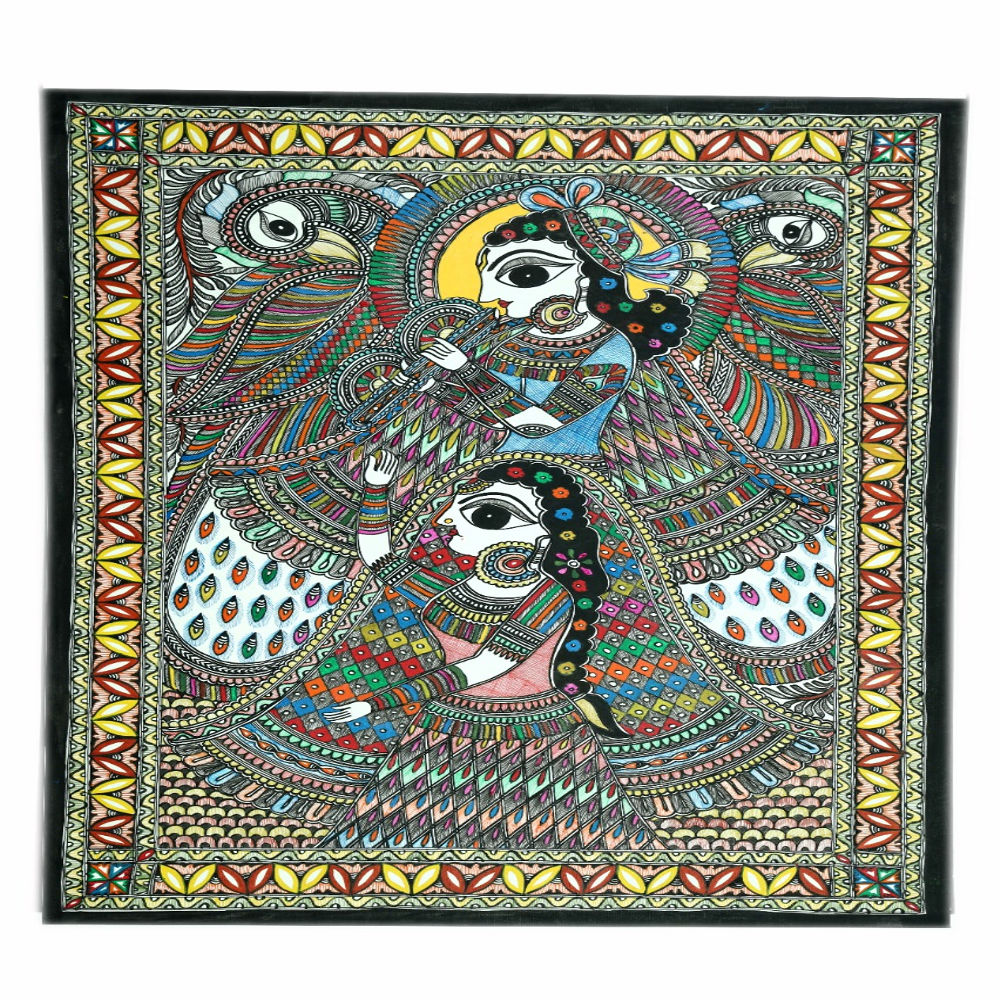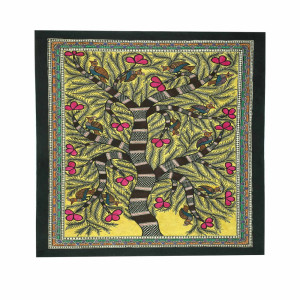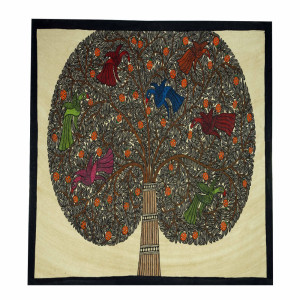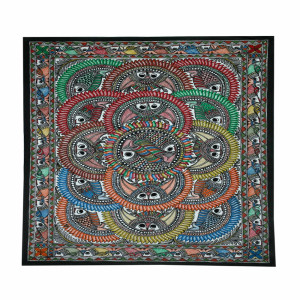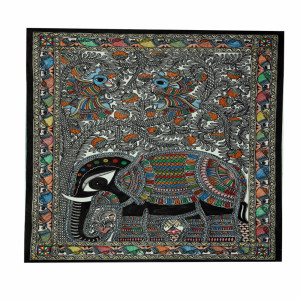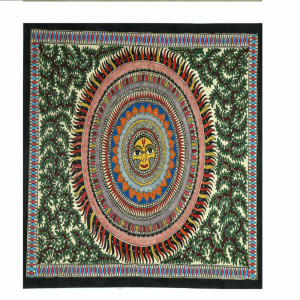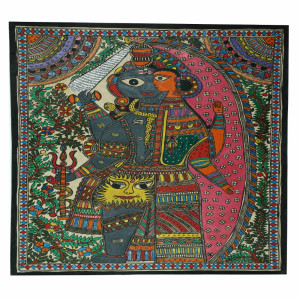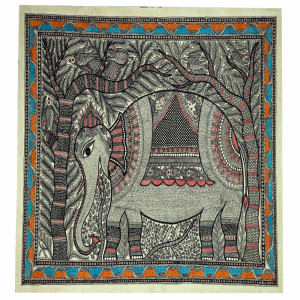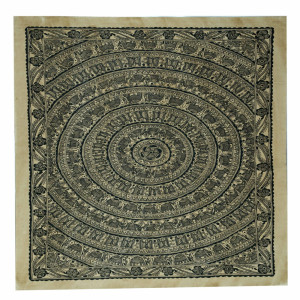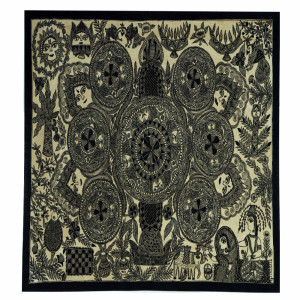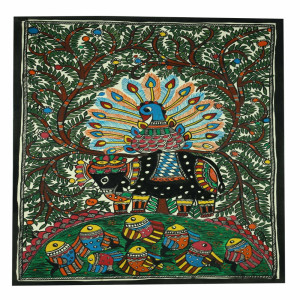Beyond Love Radha Krishna Madhubani Painting
- Product Material: Hand Made Paper
- Dimensions:20x30 Inches
- Weight: 500 gms
Description of Goods:
Traditional paintings in Mithila art encompass wall paintings, line paintings, and Godna paintings, also known as Harijan paintings. Wall paintings often depict narratives and deeper themes, serving as visual education and heritage preservation. The most elaborate wall paintings are found in the nuptial chamber (Kohbar room), blessing the couple with fertility and protection from evil spirits. Various symbols and motifs like Nayna-Jogin, Panch Gaurh, Nayagraha, and religious deities adorn these paintings, each carrying auspicious significance. Mithila art revolves around themes like Krishna's life, the story of Rama and Sita, and depictions of various deities, reflecting the cultural ethos and beliefs of the community.
Geographical area of production:
Madhubani, a district in Bihar, has been a significant hub for Mithila art production since the British period. With 34% of the district's population involved in Madhubani painting, this craft is predominantly practiced by women.
Proof of Origin:
Madhubani paintings, originally known as Mithila paintings, are deeply rooted in the rural areas of Madhubani district. The ceremonial folk paintings, dating back to ancient times, have been preserved by the women of the region. These paintings, prevalent across the Mithila region, are integral to various rituals and festivals, reflecting the traditional Hindu culture of the area. Themes for Madhubani paintings are drawn from ancient religious texts, literature, and mythology, with deities like Shiva, Krishna, and Rama being prominently featured. The paintings gained recognition globally after W.C. Archar, an ICS officer, exposed them during relief work after the 1934 earthquake. Commercialization efforts began in the late 1950s, with initiatives by companies like J. Walter Thompson Pvt. Ltd. and individuals like Babu Chandradhari Singh. Further support from organizations like the All India Handicraft Board and Union Ministry for Foreign Trade & Commerce helped in promoting Madhubani paintings as a source of income. Documentary films like "A Day in Mithila" and "Munni and Mithila Painters" further popularized these paintings internationally.
Academic Recognition:
The academic recognition of Madhubani paintings traces back to W.G. Archer, who first took notice of them in 1934 after an earthquake exposed the murals in Maithili households. His research, later published in "Marg" in 1949, provided a descriptive analysis of the subject. Mildred Archer, his wife, continued his work after his death. Maithili scholars like Lakshmi Nanth Jha and Upendra Thakur also played a crucial role in highlighting the rich cultural heritage of Mithila. Non-Maithili scholars such as J.C. Mathur, Mulk Raj Anand, and Pupul Jayakar contributed to changing existing paradigms through their writings. Later writings focused on empowering women and their individual expressions through the paintings. Scholars like Jyotida Jain and Devika Jain analyzed the works of artists like Ganga Devi and emphasized women's empowerment in the context of worldwide recognition of Madhubani art. Recent scholars like Carolya Henning Brown have delved into the distortions by earlier writers and attempted to contextualize the paintings within the cultural world of women.
Method of Production:
Madhubani paintings are created using two methods. In one method, artists prepare a sketch and fill in figures on cloth, paper, etc., using different colors. The other method, known as line painting, involves depicting articles like flutes and clothes with numerous small straight lines, which is more labor-intensive. The strong colors used in these paintings provide dramatic intensity, and each element of the subject holds special meaning for the Mithila women. While an urban artist may depict a tiger for its aesthetic appeal, in Mithila women's paintings, the animal must have some association with legend or ritual. Artists who adhere to tantras and shashtras use special symbols in their paintings.
Raw Materials:
The materials used for Madhubani painting are simple. The colors are bright and vivid, corresponding to the vibrant hues of the countryside and traditional attire. Originally, village painters used soot from night lamps for black color, turmeric powder for yellow, orange from Harshingara (Shefali) flowers, red from Kusum flowers, indigo mixed with bean leaf extract for blue, green from gum mixed with bean leaf extract, and saffron earth mixed with mustard extract for another variety of red. Fine bamboo splits were used as brushes, which tended to be more linear than imported brushes. Artists avoid redoing strokes, believing it to be inauspicious, and strive to complete each painting in one go.
Uniqueness:
Madhubani painting has gained global recognition for its unique style, offering a new dimension, horizon, and definition to the art of painting, becoming synonymous with Madhubani itself. It is an art form specialized to this region, depicting nature and mythological events. Themes often revolve around Hindu deities such as Krishna, Ram, Shiva, Durga, Lakshmi, Kali, and Saraswati, as well as natural objects like the sun, moon, religious plants like Tulsi, and social events like weddings. Artists adhere to a traditional belief of not redoing incorrect strokes, completing each painting in one go. Colors are prepared from natural sources, and raw materials are mixed with goat milk, gum Arabic, and juice from bean plants. The application of colors is flat, with no shading, and outlines are typically double-lined with the gap filled by cross or straight tiny lines.
Madhubani Painting Art earned the Geopgraphical Indication (GI) Tag in 2005.

 USD
USD INR - ₹
INR - ₹
 CAD - Can$
CAD - Can$
 EUR - €
EUR - €
 GBP - £
GBP - £
 SGD - S$
SGD - S$
 AUD - A$
AUD - A$
 MYR - (RM)
MYR - (RM)
